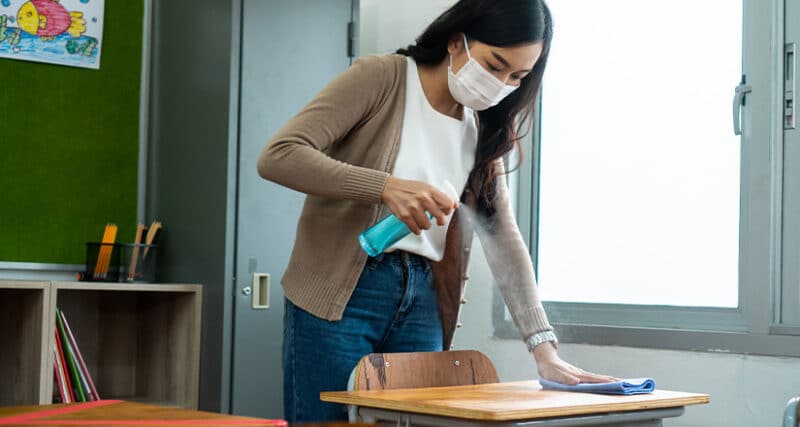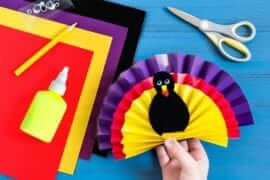A Teacher’s Top 10 Keys to COVID Hygiene in the Classroom
Classrooms have long known the fears and reality of winter germs. Where once we dreaded the common colds, strep, and flus, we now live under the angst of the highly contagious COVID-19 virus. With in-person instruction, my classroom is in need of my anti-germ winterizing more than ever! We will need to step it up with more than our usual bag of tricks, but we all know we still need the usual weapons: tissue boxes, sanitizer, disinfecting spray, and wipes. Here’s what I’m doing to keep germs out of my class, and my students and me in the classroom, where we belong.
- Open Sesame!
Here they come, walking down the hall toward your perfectly sanitized classroom! Before they reach out and touch that sparkling clean doorknob, prop that door open! Handles and doorknobs are some of the most germ-ridden objects in any classroom. As the teacher, be the one and only person who opens and closes the door. If a student touches a door knob or a handle, immediately wipe the area with sanitizer (like Lysol) to keep it clean for you, because no one touches that door as much as you the teacher.
- Wash up.
Admit it: as soon as they enter the classroom you start wondering … where are these kids coming from, what have they touched, what germs have they been around? While you cannot control the environment they came from, you have some control over the germs that are entering your room. Following protocol, I am sure they will be wearing masks, but what about those hands? Time to line those kids up at the sink (turn the water on for them and let it run to minimize germ exchange) and wash, wash, wash! If you don’t have a sink in your room, hand sanitizer is an option too. Stand at the door and pump the sanitizer directly into each student’s hands as they enter (to minimize germ exchange, don’t let them directly touch the sanitizer dispenser).
- Declutter.
Obvious measures (and probably already set in to your policies) are not only large spaces between the students, but a “no sharing” policy. Take away the markers, scissors, staplers, crayons, pencils, and computers. The truth is the kids will still need to borrow things at times. Be prepared with some low cost, give away extras like pencils, erasers, rulers, and crayon boxes. Be ready to lend out the other things, with procedures in place for sanitization between uses. Label a return bin as “to be cleaned” and keep it in a separate location from the disinfected lending materials.
- Stay in your seat.
Sanitizer bottles have surely already been placed in your classrooms. But, social distancing rules do not encourage our students to move around the room much, so one or two tissue boxes and sanitizer bottles strategically placed is no longer a viable options in a classroom. If you are able, try giving each student a mini sanitizer bottle and tissue pack for their own desk; this keeps them in their seats and sanitized.
- Wipe- Spray-Clean.
This one is obvious, but this chore doesn’t have to fall completely on you. Ask the students to wipe their own desks and seats when they are finished with an area. Keep an eye on this, in case you feel like some kids need to be instructed in best cleaning methods, or so you know which areas will need to be wiped down again later. This can be done at the close of the day, or even between classes if you have older kids. Due to COVID, there are probably no shared supplies in your room, but if any shared resources go out (computers, staplers, tape markers, whiteboards) make sure to wipe everything down before returning to their proper locations. For good measure, Lysol cloud desks and shared space areas after the students have vacated the room.
- No water fountain!
When checking where the germs are hiding in school buildings, many studies have shown that the water fountains have more bacteria than any other surface in the building! It is very possible that the school has already closed the water fountains, but if not, keep your kids away! This is one instruction I tell my own children as well. Instead, I encourage my students to have their own water bottle kept with them at all times. Of course, follow school procedures on when students can eat or drink and if/when masks can come off.
- Clear the air.
This is a luxury item that you may not have access to, but an air purifier is helpful in any classroom. At least crack the windows every once in a while, even if it’s cold, to help clear the air.
- HIDE your supplies.
Sharing is not always caring! As a teacher, I am not keen on my students touching my pens, pencils, stapler, and anything else on my desk that will transfer their germs to my hands. Make sure you have your own supplies that you keep inside your desk. Encourage your students to bring their own supplies daily.
- Stay healthy
Do the extra for yourself, and encourage your students to do the same. That means eating healthy, drinking lots of water, and getting extra sleep. I am personally also a believer in extra supplements that boost the immune system and help to fight any germs that might sneak in: this includes vitamin C, Echinacea, elderberry, Airborne, Emergen-c, apple cider vinegar, and honey. You might even consider giving yourself the extra protection of a flu shot or COVID-19 vaccine.
- Time to prepare.
Be prepared, because inevitably, even after all precautionary efforts, you will still get sick sometimes – I’m not saying COVID, but something will get you before the winter is over. When you feel it coming, push those emergency plans aside and prepare some real plans that will occupy your students and continue to cover your curriculum. Plan for a few days, just in case. With this peace of mind, you can get the rest you need without worrying about your classroom and kids. So grab the tea with honey and sleep those germs away.





